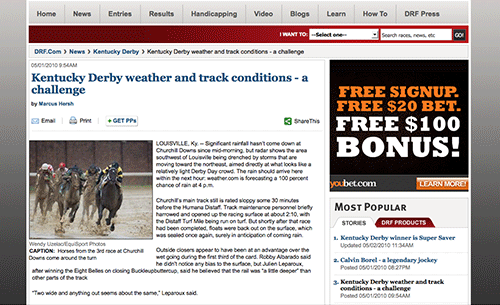Blood-Horse
Via @sidfernando comes this news of retired rider Richard Migliore:
Rich wants to start racing partnership. A more intimate partnership. #
The name of The Mig’s racing venture is called Pantheon Racing. Look for website and brochure this week, hopefully, Mig said. #
The Mig: “We want people to have great relationships and experiences. Want to show what it’s like participating in industry.” #
Good luck, Mig!
If you’re interested in owning horses, the Blood-Horse is offering a free webcast on thoroughbred racing partnerships on Tuesday at 1:00 PM ET. Executive editor Evan Hammonds and West Point Thoroughbreds founder Terry Finley will take questions. You can get all the details and register here.
Ugh. This Blood-Horse headline qualifies as a gross error:
An Associated Press article has the slightly better headline, “Paterson: NYRA, Saratoga meet will be saved,” so readers aren’t told the proposed $17 million loan is a bailout … until the story’s first sentence. While not overlooking the good news that the state may come through with the money it’s obligated to provide NYRA (money it desperately needs) if the Aqueduct racino wasn’t in operation this spring, it’s hard to see the inaccurate characterization of the deal in the AP lede, and in at least one headline from a publication that should know better, as anything other than a public relations disaster. I look forward to the inevitable editorials and letters demanding to know why New York, with its seven weeks overdue budget, is “bailing out” the undeserving NYRA, when it’s merely fulfilling the promises of the franchise agreement made in 2008.
5/19/10 Update: Never mind? Matt Hegarty reports in DRF that the Governor’s comments “did not reflect any substantive progress” towards a legislative resolution to NYRA’s situation. “I think they’ll pass it,” said Paterson of the proposed loan plan on Tuesday, but a few legislators may balk.
– – – – –
Meanwhile, in California …
A shame CHRB cut meeting webcasts in January; items #10 and #11 on the board’s Thursday meeting agenda (PDF) should be quite interesting. Magna (MI Developments) is scheduled to give an update on its future racing plans, which won’t include Santa Anita president Ron Charles. He’s resigned, effective Wednesday. A discussion of the voided Oak Tree lease (and potential impact on Oak Tree dates this fall) is to follow. Oak Tree had been talking with the Breeders’ Cup about hosting the event permanently; MI’s decision to pull the lease, affirmed only two weeks before, has complicated those negotiations. “Maybe this will derail BCup freight chugging into SA station,” tweeted Nick Kling. Maybe. Del Mar executives, who have offered the track to Oak Tree, are hoping it might renew the possibility of a Del Mar Breeders’ Cup.
In the wake of developments at Blood-Horse and Newsweek, Ray Paulick is pondering the future of print. Replying to an observation I made here, he asks:
But can a robust digital strategy financially carry a flagging print product?
Let’s leave aside for now the implicit assumption in the question of print’s primacy, and reframe it: What digital strategy can carry a print product?
For clues, look to the venerable Atlantic:
This year, with print revenues holding steady in the down market, digital and event revenues are expected to make up nearly half of the [Atlantic’s] total haul. For the month of April, according to Mr. Smith, The Atlantic brought in more revenue from digital advertising than it did from print.
Or to Newsweek editor Jon Meacham, reportedly working on a bid to buy the magazine, who told Jon Stewart on the Daily Show that “it’s probably time to flip” the focus of production from print to digital.
Derek Powazek offers five easy steps on how a magazine might make that flip. Of course, there’s nothing easy about altering the brutal economics of weekly publishing, but Powazek’s advice includes a couple recommendations that seem particularly pertinent to racing magazines, such as connecting to your community, looking to tiered subscribers for revenue (which means developing digital products they’ll pay for), and using print to package the best from the previous week (or month). The last point is crucial: A weekly print magazine isn’t delivering the news, it’s archiving it — make each issue worth keeping.
Is a DRF.com redesign in the works? Earlier this afternoon, a correspondent emailed a URL — accidentally discovered through a Google search and completely unprotected — that appears to be a Daily Racing Form development site. The new look, obviously in progress and still a little rough, has a smart and modern feel and makes racing information more visible on the main page (very Racing Post of them). It’s also built on Drupal, an open source CMS that attracted good buzz this week when the Nation announced it was the system underlying their freshened site.
Screenshots (homepage, interior page, navigation detail):


The DRF site was last updated in January 2007 (a project I was very much involved with as site manager); the redesign then was geared towards its existing audience. What’s interesting about the direction DRF seems to be going in with this look is that, in addition to making the site more functional for users who are already horseplayers and DRF customers, there appears to be an emphasis on making the site (and game, presumably, based on the recent introduction of a product like EasyForm) more accessible to new players and casual fans. Note the tabs “Learn” and “How To” in the navigation bar — fan education is more prominent than it is on the current site.
Copyright © 2000-2023 by Jessica Chapel. All rights reserved.